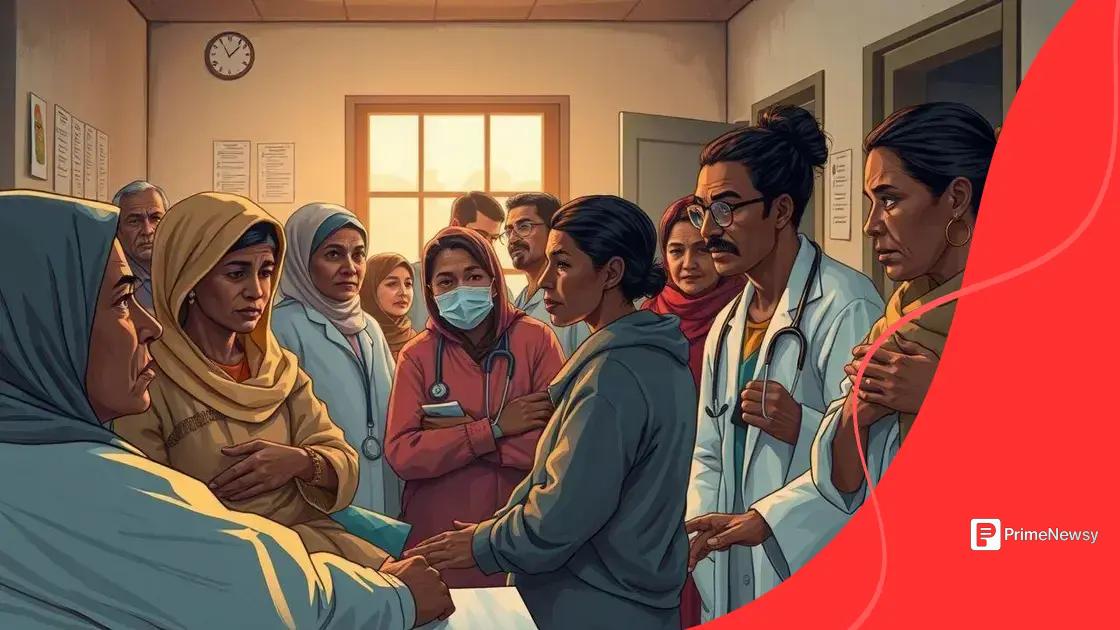Healthcare access disparities are impacting millions

Anúncios
Healthcare access disparities refer to the unequal distribution of healthcare resources and services among different populations, which leads to significant differences in health outcomes based on factors such as income, location, and insurance coverage.
Healthcare access disparities are an undeniable reality in today’s society, affecting how people receive essential medical services. Have you ever wondered how these gaps influence the lives of millions? Let’s dive into this critical issue.
Anúncios
Understanding healthcare access disparities
Understanding healthcare access disparities is crucial for addressing the challenges many face in obtaining medical services. These disparities often stem from a range of factors that complicate healthcare delivery.
Key Factors Influencing Disparities
Several important elements contribute to healthcare access disparities. These factors can vary significantly depending on geographic, economic, and social conditions.
- Economic status: Individuals from lower-income backgrounds often struggle to afford necessary care.
- Geographic location: Rural areas may lack sufficient healthcare facilities and professionals.
- Insurance coverage: Those without adequate health insurance are at a disadvantage when seeking medical help.
- Education: Limited health literacy can prevent individuals from accessing available services.
As we explore these issues further, it’s essential to recognize how systemic barriers impact vulnerable communities. For example, people in rural areas not only face a lack of healthcare providers but also often have to travel long distances for care. This can discourage individuals from seeking necessary treatment, leading to worse health outcomes.
Anúncios
Impact on Communities
The impact of healthcare access disparities extends beyond individual health. Communities that experience these gaps often end up with poorer overall health metrics, increasing healthcare costs for local systems. Additionally, social determinants like transportation, employment, and education significantly influence these issues. Addressing one aspect, such as transportation, can improve access and lead to better health outcomes.
Moreover, understanding these disparities is vital for implementing effective solutions. By recognizing the underlying factors, stakeholders can develop targeted interventions tailored to specific communities’ needs. This approach can help bridge the gap in access and improve health equity.
Key factors contributing to disparities
Several critical elements contribute to healthcare access disparities. Understanding these factors is essential for creating solutions that can bridge the gap in health services.
Economic Barriers
One of the primary challenges is economic barriers. Individuals from lower-income families often find it hard to pay for medical care or insurance, which limits their access to necessary treatments. This situation can lead to worse health outcomes and increased hospital visits.
- High costs of treatments and medications.
- Lack of affordable health insurance options.
- Inability to pay for transportation to healthcare facilities.
These economic challenges are compounded by lack of awareness or confidence in navigation of the healthcare system.
Social Determinants
Social determinants, such as education and neighborhood stability, also play significant roles. Individuals with a lower level of education may not understand how to seek help or the importance of regular check-ups. Additionally, people living in unstable neighborhoods often face violence or transportation issues that affect their ability to access care.
For instance, someone living in a neighborhood with no nearby clinics may avoid seeking help even when it’s needed, fearing the long journey or potential dangers.
Insurance Coverage
The type and extent of insurance coverage further influence access. Without proper insurance, many individuals may delay care until issues become severe, driving up costs and complicating treatments. Understanding insurance options can be a daunting task, especially for those unaware of available resources.
- Limited coverage for specific services can lead to gaps in care.
- Many insurance plans have high deductibles, making it financially challenging to seek care.
- Medicaid and Medicare availability varies by state, affecting accessibility.
By addressing these key factors, we can begin to understand the complexity of healthcare access and work towards solutions that ensure everyone has the opportunity to receive adequate care.
Impact on vulnerable populations

The impact of healthcare access disparities on vulnerable populations is profound and multi-faceted. These groups often face greater challenges in obtaining the care they need, which can lead to significant health risks.
Health Outcomes
Individuals in vulnerable populations, such as low-income families and marginalized communities, frequently experience worse health outcomes. These disparities can be seen in higher rates of chronic diseases like diabetes and hypertension, which are often exacerbated by limited access to preventative care.
- Challenges in receiving timely diagnoses.
- Increased emergency room visits due to untreated conditions.
- Higher morbidity and mortality rates compared to more affluent communities.
Many of these individuals may avoid seeking care due to cost or lack of transportation, resulting in delayed treatment and worse health outcomes.
Mental Health Consequences
The lack of access to necessary healthcare also impacts mental health. Vulnerable populations often suffer from chronic stress due to financial instability and health issues. This can lead to conditions such as anxiety and depression, which may go untreated due to a lack of resources.
Furthermore, the stigma associated with seeking help can prevent individuals from accessing mental healthcare services, further compounding their issues. The cycle of poor health and limited access creates a significant barrier to overall well-being.
Community Impact
Beyond individual consequences, these disparities affect entire communities. Poor health within a population can lead to increased healthcare costs, reduced productivity, and diminished quality of life. Communities with high rates of disease often experience an economic burden that can stifle growth and opportunity.
Addressing the healthcare access disparities experienced by vulnerable populations is crucial for improving overall community health. By targeting resources and support to these groups, we can help foster healthier environments that encourage access to essential healthcare services.
Strategies to improve healthcare access
Improving healthcare access requires a multifaceted approach. Various strategies can help bridge the gap for those facing barriers to essential medical services.
Enhancing Transportation Options
Access to reliable transportation is crucial for many individuals. When people cannot reach healthcare facilities easily, they miss appointments and neglect necessary care. Communities can enhance healthcare access by developing transportation programs.
- Offering free or low-cost shuttle services to medical appointments.
- Creating partnerships with ride-sharing companies for discounted rides.
- Implementing mobile health clinics that visit underserved areas.
These efforts can significantly reduce the transportation barriers faced by vulnerable populations.
Expanding Telehealth Services
Telehealth has emerged as a powerful tool for increasing healthcare access. It allows patients to consult with healthcare professionals from the comfort of their homes. This is especially beneficial for those in remote areas or with mobility challenges.
Telehealth can offer services such as:
- Virtual check-ups for chronic illness management.
- Online consultations for mental health support.
- Remote monitoring for patients recovering from surgery.
By expanding telehealth options, communities can ensure more individuals receive the care they need when they need it.
Community Health Initiatives
Community-driven health programs play a vital role in addressing local disparities. These initiatives can promote awareness and education around healthcare resources. They empower communities to take charge of their health, making it easier for individuals to seek help.
Some effective community health strategies include:
- Organizing health fairs that provide free screenings and educational materials.
- Training community health workers to assist people in navigating the healthcare system.
- Conducting outreach programs to inform populations about available services.
These strategies foster a supportive environment that encourages health-seeking behavior and enhances access.
The role of policy in reducing disparities
The role of policy in reducing healthcare access disparities is vital for creating a more equitable health system. Effective policies can address the systemic barriers that hinder access for many individuals.
Creating Equitable Healthcare Laws
One way policies can reduce disparities is by establishing laws that ensure equitable healthcare access. This includes protecting individuals’ rights to receive care regardless of their background or financial situation.
- Implementing legislation that guarantees coverage for essential health services.
- Ensuring that healthcare facilities are adequately funded in underserved areas.
- Supporting initiatives that provide health insurance to uninsured populations.
These measures are essential for leveling the playing field and ensuring that all individuals can access necessary care.
Funding and Resource Allocation
Government policies can also influence how resources are allocated within the healthcare system. Proper funding targeted at vulnerable communities can lead to improved health outcomes. This may involve dedicating resources to:
- Expand community health centers that cater to low-income populations.
- Provide grants for preventive care programs.
- Support training initiatives for healthcare providers that focus on cultural competency.
By focusing on resource allocation, policies can help ensure that healthcare access is fair and just for everyone.
Collaboration Across Sectors
Reducing disparities also requires collaboration between healthcare systems, governments, nonprofit organizations, and community groups. Policies that encourage partnerships can enhance efforts to address access issues. For instance, collaborative programs can focus on:
- Outreach initiatives that educate communities about available health services.
- Shared resources between organizations to provide comprehensive care.
- Joint efforts to advocate for more inclusive policies.
Such collaborations are essential to tackle the complexities of healthcare access and improve outcomes for all.
FAQ – Frequently Asked Questions about Healthcare Access Disparities
What are healthcare access disparities?
Healthcare access disparities refer to the differences in the availability and quality of healthcare services between different populations, often influenced by factors like income, geographic location, and race.
How can transportation improvements help with healthcare access?
By providing reliable transport options, individuals can more easily reach healthcare facilities, reducing missed appointments and improving overall health outcomes.
What role does telehealth play in reducing disparities?
Telehealth allows patients to receive medical consultations remotely, helping those in rural areas or with mobility challenges access necessary healthcare services without traveling.
Why is policy important in addressing healthcare access issues?
Effective policies can ensure fair resource allocation, support community health initiatives, and create a legal framework that protects individuals’ rights to healthcare.